Key takeaways
- Stage presence involves confidence, body language, eye contact, connection, and energy management to engage the audience authentically.
- Transforming nervousness into strength enhances performance, allowing the audience to feel a real and profound connection.
- Building a personal performance style requires self-reflection, studying admired artists, purposeful movement, and audience engagement.
- Preparation and practice are vital for effective performances, as seen in Beyoncé’s approach to confidence and authenticity on stage.
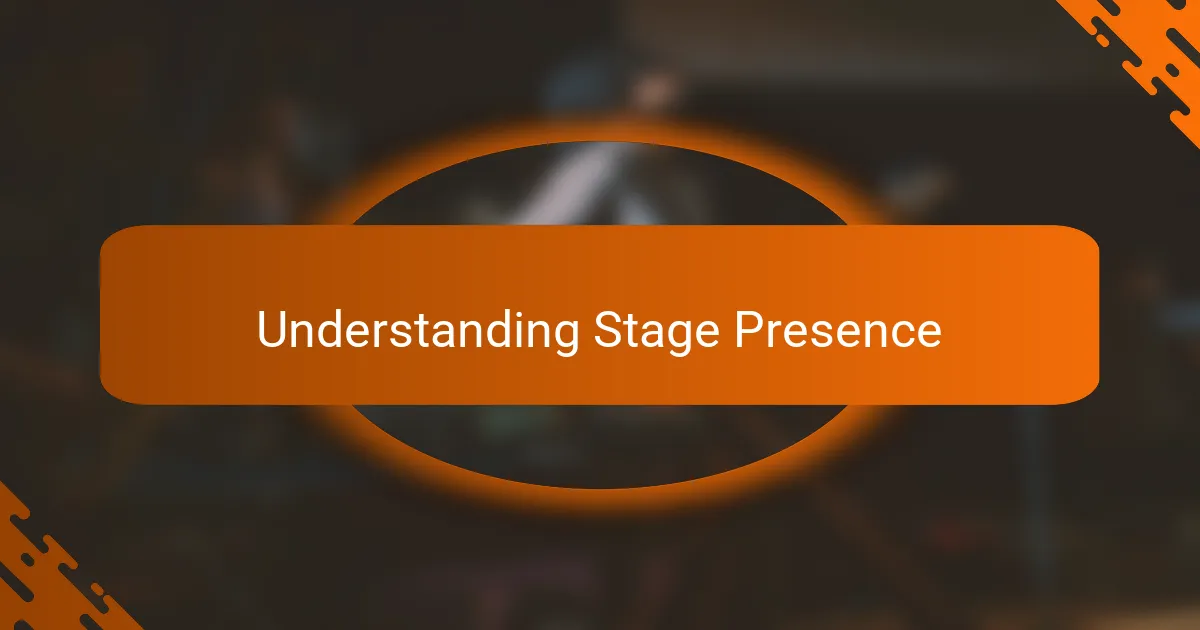
Understanding stage presence
Stage presence is not just about being seen; it’s about being felt. When I first stepped onto a stage, I realized that the audience wants to connect with you. I remember feeling the rush of adrenaline while facing a crowd, and it became clear that my energy, movements, and expressions were crucial in captivating them. It’s about showing authenticity and emotion, allowing the audience to see the real you.
To truly understand stage presence, consider the following elements:
- Confidence: It shines through in every performance. I learned that believing in myself made the audience believe in me too.
- Body Language: Movements can convey messages. I realized that an expressive gesture could resonate more than words.
- Eye Contact: This creates a bond. Looking into the eyes of audience members made me feel connected and vulnerable at the same time.
- Connection: Engaging with the audience transforms a performance into a shared experience.
- Energy Management: Balancing excitement and calmness helps maintain a captivating atmosphere. I often find moments of stillness to build anticipation.
By embracing these aspects, stage presence becomes an extension of who you are as an artist.
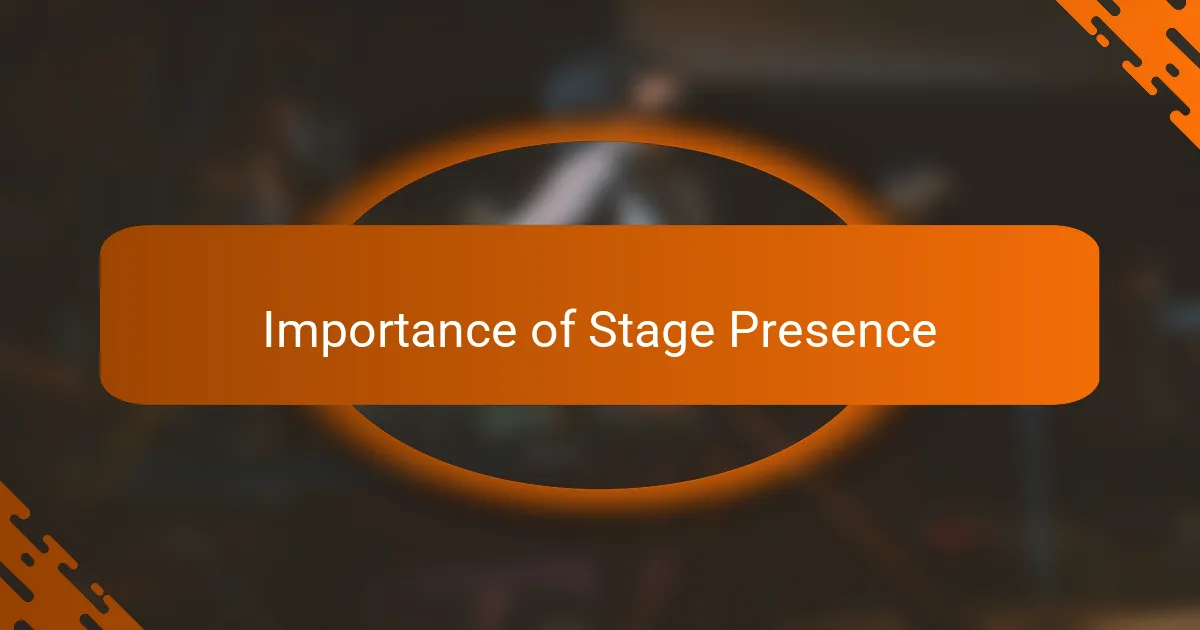
Importance of stage presence
When I think about the importance of stage presence, I immediately recall a performance where I felt utterly alive. I was pouring my heart into each note, and I could feel the audience’s energy washing over me. It reinforced my belief that a powerful stage presence can transform a simple performance into something unforgettable. Have you ever had that moment when you felt completely connected to your audience? It’s electric.
Stage presence isn’t merely about showcasing talent; it’s about creating an experience. I learned that the way I move and interact can make or break a moment. During one show, I noticed how a simple smile or an inviting gesture could draw people in, making them feel like participants rather than mere spectators. That realization was pivotal—I understood that engaging my audience was as vital as hitting the right notes.
Connecting through stage presence can even turn nervousness into strength. I recall a time when I felt anxious before going on stage. Instead of letting it consume me, I channeled that energy into creating a vibe that the audience could feel. It’s incredible how that shift not only calmed my nerves but also resonated deeply with those watching. This taught me that stage presence is, at its core, about inviting the audience into your world—making them feel something real and profound.
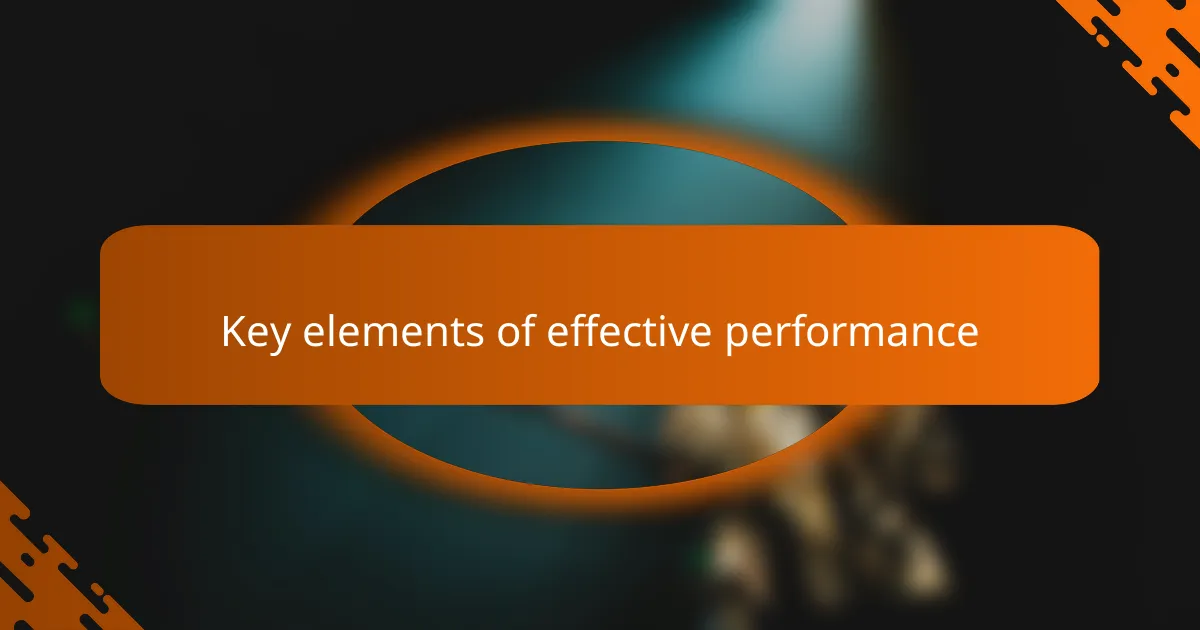
Key elements of effective performance
Developing a captivating stage presence is all about the essentials that resonate with the audience. From my experience, confidence is crucial; when you’re self-assured, it radiates and draws the crowd in. I remember the first time I performed live, my nerves were palpable. Yet, as I focused on connecting with my audience, I felt the energy shift. It was an exhilarating moment that taught me the power of presence.
Another key element is authenticity. Audiences can sense when a performer is genuinely connected to their material. I’ve found that sharing personal stories or emotions during performances not only engages listeners but creates a memorable experience for everyone involved. The more real you are on stage, the more likely people will be to relate to you.
Here are some key elements to consider for effective performance:
- Confidence: Believe in yourself and your abilities.
- Connection: Engage with the audience through eye contact and interaction.
- Authenticity: Share your true self and personal stories.
- Energy: Keep your performance dynamic and responsive to the audience’s reactions.
- Preparation: Rehearse thoroughly to build familiarity and ease on stage.
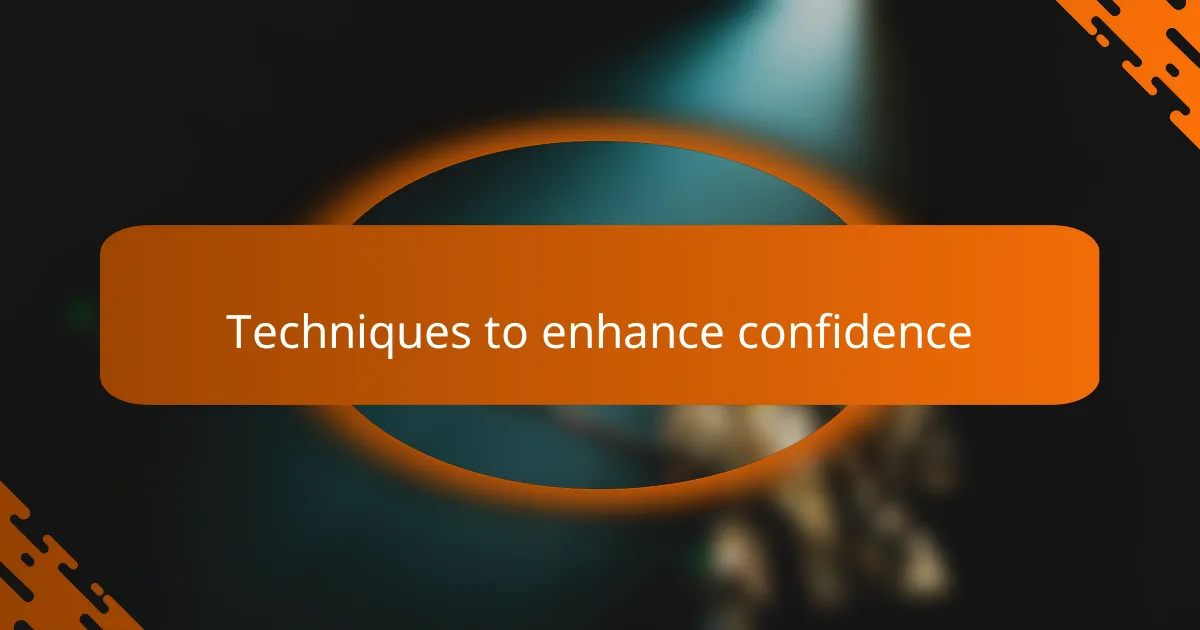
Techniques to enhance confidence
Building confidence on stage is so crucial for any performer, and I’ve learned a few techniques that transformed my own presence. One of my favorite methods is visualization. Before a performance, I picture myself owning the stage, feeling the energy from the audience. This exercise helps calm my nerves and boosts my confidence.
Another impactful technique is practicing mindfulness. I take a moment to breathe deeply and center myself, which tunes me into the present. This little ritual reminds me that the performance is about sharing my passion, not just about being perfect.
Moreover, engaging with the audience is vital. I remember my first big audience; I made eye contact and connected with them. That interaction immediately made me feel more secure and energized. Confidence grows when you build that bond with the people listening.
| Technique | Description |
|---|---|
| Visualization | Picturing yourself confidently on stage before a performance. |
| Mindfulness | Practicing deep breathing to center yourself before performing. |
| Audience Engagement | Making eye contact and connecting with the audience during the performance. |
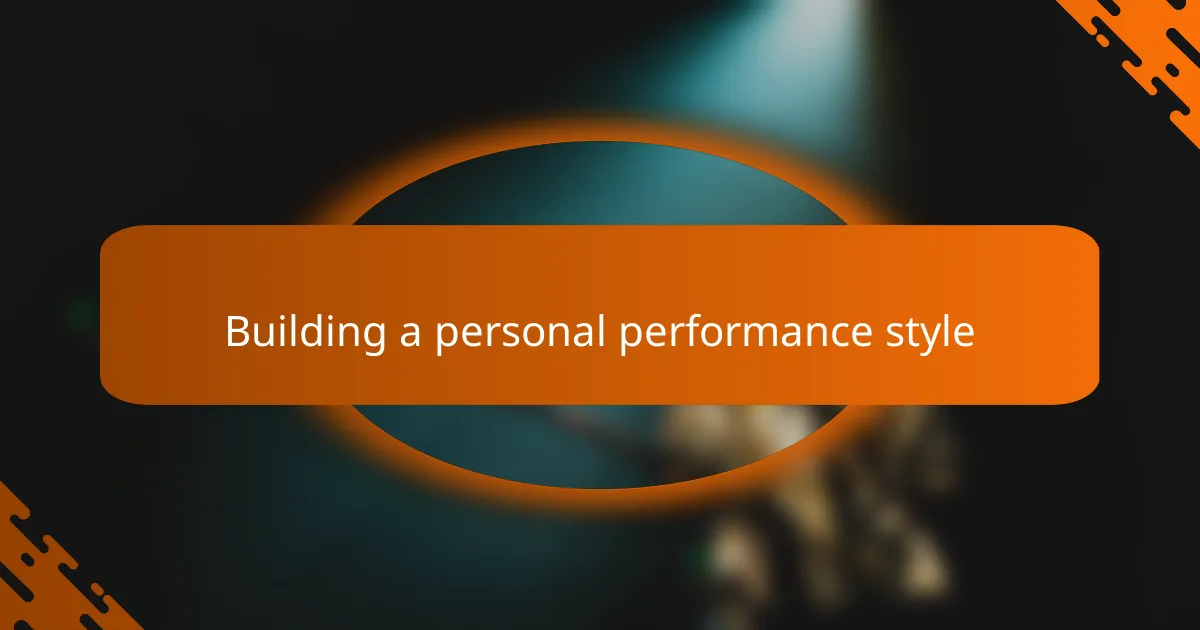
Building a personal performance style
When I first started performing, I was overwhelmed by the thought of developing a unique style. I quickly learned that it wasn’t just about hitting the right notes; it was about how I expressed myself on stage. I remember watching Beyoncé and feeling a rush of inspiration. Her ability to connect with the audience made me realize that mastering stage presence was about authenticity, not just mimicry.
Through trial and error, I discovered what felt true to me. I began focusing on movements that matched my music’s energy and my personal story. Each performance became an opportunity to share a piece of myself, allowing the audience to feel my passion. Here are some key strategies I used to build my own performance style:
- Self-Reflection: Think about what truly resonates with you — your values, experiences, and emotions.
- Watching Live Performances: Study artists you admire, noting what elements of their stage presence inspire you.
- Moving with Purpose: Practice your stage movements, ensuring they enhance the song’s emotion rather than distract from it.
- Engaging the Audience: Create moments of connection, whether through eye contact or interactive elements.
- Finding Your Signature: Experiment with costumes, props, or unique vocal embellishments that reflect your personality and brand.
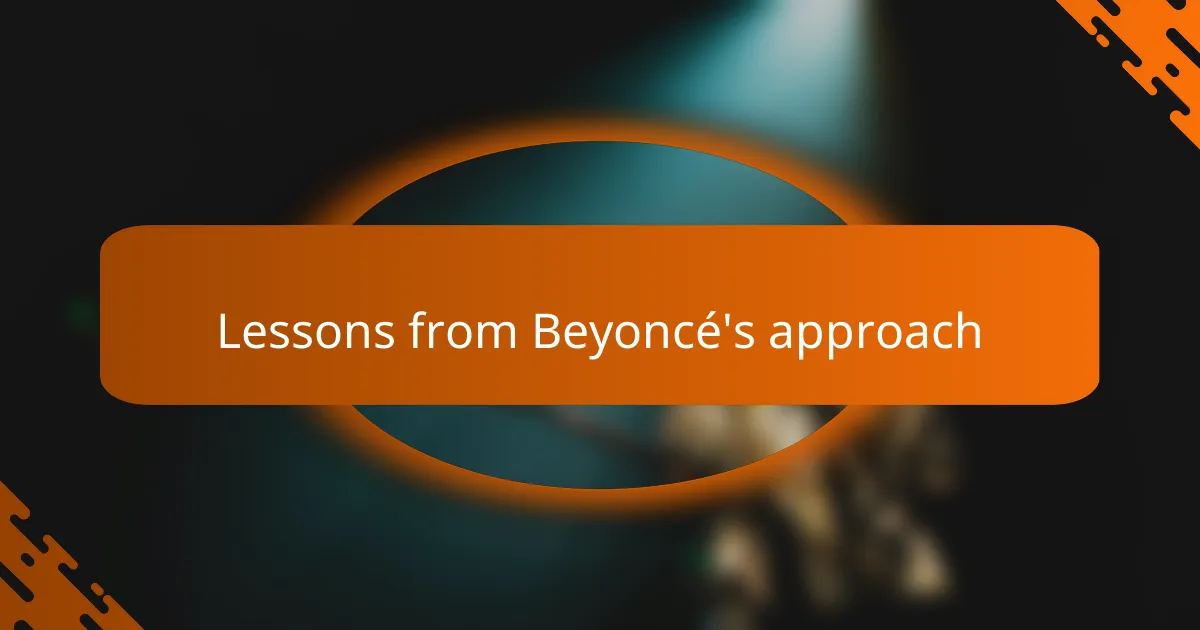
Lessons from Beyoncé’s approach
When I think about Beyoncé’s magnetic stage presence, it’s clear that she embodies confidence and authenticity. This makes me reflect on my early performances, where I often let nerves overshadow my true self. What I learned from Beyoncé is that embracing vulnerability can actually elevate your performance, allowing the audience to connect with you on a deeper level.
Beyoncé also emphasizes the importance of preparation and dedication. I remember spending countless hours rehearsing, and during those times, I underestimated the power of perfecting every small detail. These lessons were invaluable; they taught me that hard work and every little nuance contribute to an unforgettable show. Here are some key takeaways from her approach:
- Confidence is key: Believe in yourself and own the stage.
- Authenticity matters: Let your true self shine through in your performances.
- Practice relentlessly: Rehearse until every move feels second nature.
- Engage with the audience: Make eye contact and connect emotionally to create a memorable experience.
- Choreography and movements: Every gesture should feel intentional and part of the narrative.
Beyoncé’s journey inspires me to continually refine my stage presence while reminding me of the power of authenticity and connection.
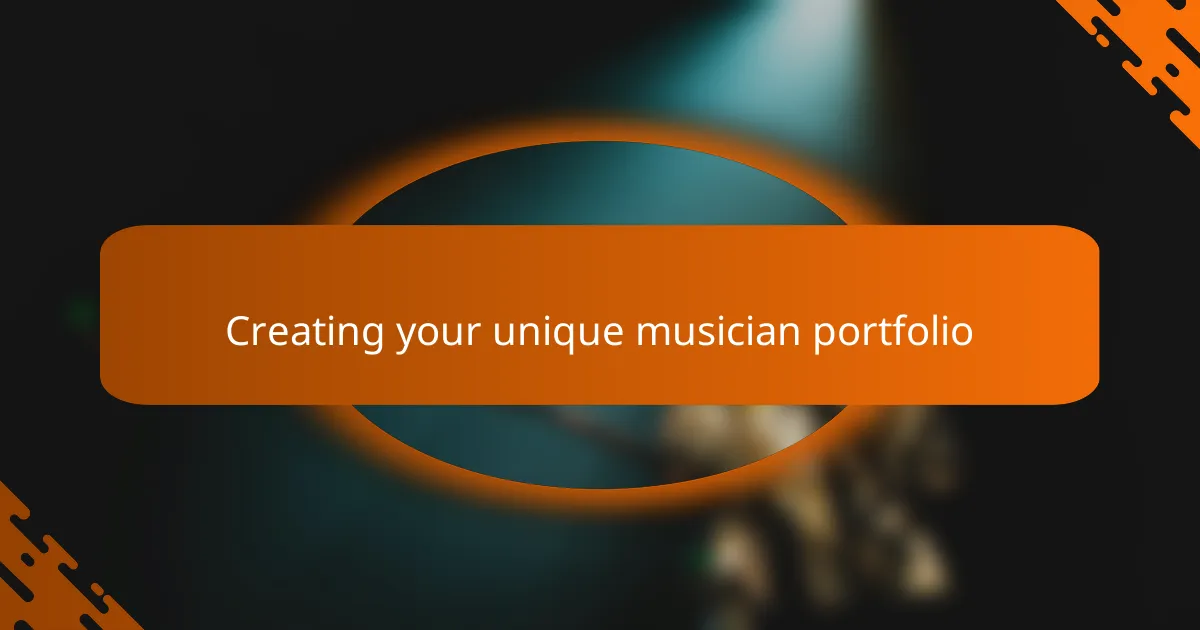
Creating your unique musician portfolio
Creating a unique musician portfolio is all about showcasing your individuality. I remember when I first started, my portfolio was a reflection of my early influences, but as I grew, I realized the importance of authenticity. I began to highlight my original music, performance videos, and personal stories that resonated with my audience, and that made all the difference.
One key aspect is presentation. I often emphasize quality over quantity. It’s better to have a few well-produced tracks that truly represent you than a long list that lacks depth. This personal touch not only enhances your portfolio but also connects with listeners on a deeper level, creating lasting impressions.
When I constructed my own portfolio, I focused on adding elements that were true to my style — striking visuals, snippets of my live performances, and heartfelt descriptions of my journey. This created a narrative that my fans could engage with, and I found that sharing my true self resonated far more than any polished image ever could.
| Aspect | Traditional Portfolio | Unique Portfolio |
|---|---|---|
| Content | Standard bios and photos | Original music, personal stories, and live performance clips |
| Engagement | Static and impersonal | Dynamic, relatable, and emotional connection with audience |
| Presentation | Overly polished and generic | Authentic and unique visuals that reflect personal style |